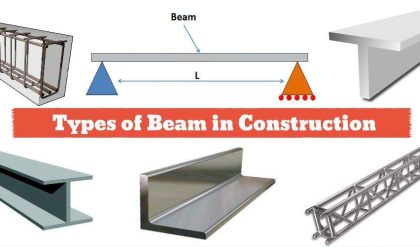Diameter of the bolts
In general, a connection with few larger diameter bolts are economical than a connection with smaller diameter bolts. This is basically because as the number of bolts increases, the work associated with drilling of holes and installations of bolts will also increases. Larger diameter bolts are particularly advantages in the case of connections where bolt shear governs the design because the shear strength of bolts varies as the square of bolt diameter.
2. Pitch
Spacing of bolt holes in ajoint is defined by three parameters namely; pitch, edge distance an end distance. Pitch is the distance between the centers of two consecutive bolts measured along a row of bolts. When the bolts are placed staggered, then the pitch is known as staggered pitch.
2.1. Minimum pitch
This is to prevent the bearing failure of the plate between the two bolts, to permit the efficiency in installation of bolts by providing sufficient space for tightening of bolts, to prevent overlapping of washers and to provide adequate resistance to tear out of bolts.
Minimum Spacing is specified by IS 800:2007 in cl. 10.2.2. The distance between centre of fasteners shall not be less than 2.5 times the nominal diameter of the fastener.
2.2. Maximum Spacing
This is to ensure a compact joint reducing the length of connection and to ensure uniform stress in
bolts
Cl. 10.2.3.1 gives the maximum distance between the centres of any two adjacent fasteners which shall not exceed 32t or 300 mm, whichever is less, where t is the thickness of thinner connected plate. Cl.10.2.3.2 gives the distance between the centres of two adjacent fasteners (pitch) in a line lying in the direction of stress, which shall not exceed 16t or 200 mm, whichever is less, in tension members and 12t or 200 mm, whichever is less, in compression members; where t is the thickness of the thinner plate. In the case of compression members wherein forces are transferred through butting faces, this distance shall not exceed 4.5 times the diameter of the fasteners for a distance equal to 1.5 times the width of the member from the butting faces.
Cl. 10.2.3.3 specifies the distance between the centres of any two consecutive fasteners in a line adjacent and parallel to an edge of an outside plate shall not exceed 100 mm plus 4t or 200 mm, whichever is less, in compression and tension members; where t is the thickness of the thinner outside plate. Cl. 10.2.3.4 deals with the staggered fasteners. When fasteners are staggered at equal intervals and the gauge does not exceed 75 mm, the spacing specified in 10.2.3.2 and 10.2.3.3 between centres of fasteners may be increased by 50 percent, subject to the maximum spacing specified in 10.2.3.1.
2.3. Edge and End Distances
Cl. 10.2.4.1 specifies the way to compute the edge distances in various cases. The edge distance is the distance at right angles to the direction of stress from the centre of a hole to the adjacent edge. The end distance is the distance in the direction of stress from the centre of a hole to the end of the element. In slotted holes, the edge and end distances should be measured from the edge or end of the material to the centre of its end radius or the centre line of the slot, whichever is smaller. In oversize holes, the edge and end distances should be taken as the distance from the relevant edge/end plus half the diameter of the standard clearance hole corresponding to the fastener, less the nominal diameter of the oversize hole.
Cl. 10.2.4.2 gives the minimum edge distance. The minimum edge and end distances from the centre of any hole to the nearest edge of a plate shall not be less than 1.7 times the hole diameter in case of sheared or hand-flame cut edges; and 1.5 times the hole diameter in case of rolled, machineflame cut, sawn and planed edges.
Cl. 10.2.4.3 specifies the permissible maximum edge distance. The maximum edge distance to the nearest line of fasteners from an edge of any un-stiffened part should not exceed 12t?, where ? = ?(250/fy) and t is the thickness of the thinner outer plate. This would not apply to fasteners
interconnecting the components of back to back tension members. Where the members are exposed to corrosive influences, the maximum edge distance shall not exceed 40 mm plus 4t, where t is the thickness of thinner connected plate.
2.4. Tacking Fasteners
In case of members covered under 10.2.4.3, when the maximum distance between centres of two adjacent fasteners as specified in 10.2.4.3 is exceeded, tacking fasteners not subjected to calculated stress shall be used. Tacking fasteners shall have spacing in a line not exceeding 32 times the thickness of the thinner outside plate or 300 mm, whichever is less. Where the plates are exposed to the weather, the spacing in line shall not exceed 16 times the thickness of the thinner outside plate or 200 mm, whichever is less. In both cases, the distance between the lines of fasteners shall not be greater than the respective pitches. All the requirements specified in 10.2.5.2 shall generally apply to compression members, subject to the stipulations in Section 7 affecting the design and construction of compression members. In tension members (see Section 6) composed of two flats, angles, channels or tees in contact back to back or separated back to back by a distance not exceeding the aggregate thickness of the connected parts, tacking fasteners with solid distance pieces shall be provided at a spacing in line not exceeding 1000 mm. For compression members covered in Section 7, tacking fasteners in a line shall be spaced at a distance not exceeding 600 mm. These specifications are outlined in Cl. 10.2.5 of IS 800: 2007.
2.5. Combination of fasteners
When different fasteners are used to carry shear loads or when welding and other types of fasteners are combined together, then one form of the fasteners should be designed to take up the total load. Nevertheless, if we use HSFG bolts along with welds and the bolts are tightened after welding is completed, then such bolts can be used to share the load with the welds.



